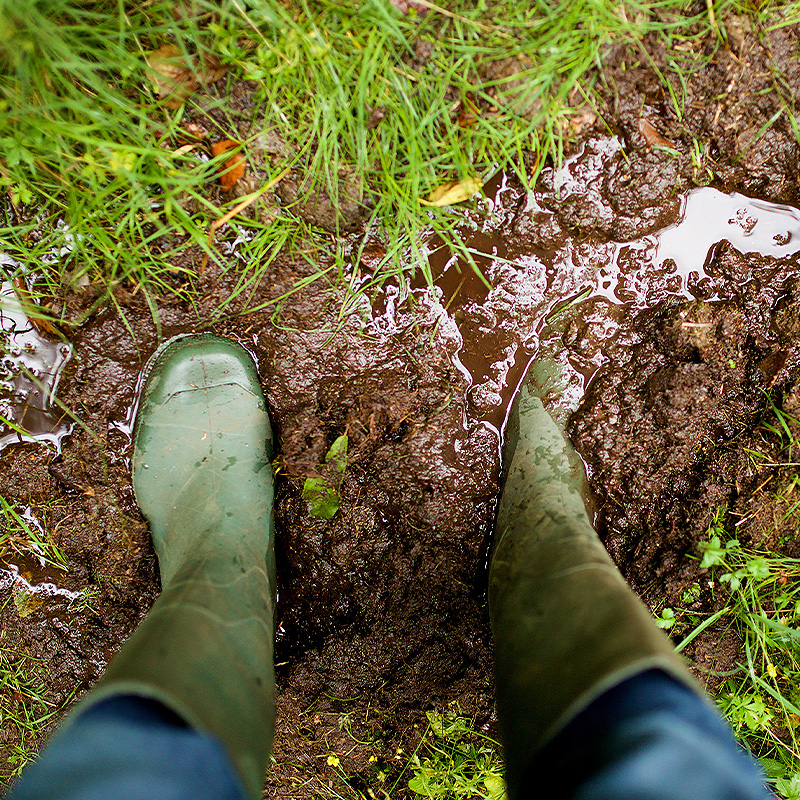More water is always good for plants, right? Wrong! When wet soil sits in the landscape, air is displaced, smothering plant roots and leading to damage. This stress manifests in wilting leaves, browning edges, poor color, and stunted growth. However, excess moisture isn’t always due to overwatering—it could be caused by poor drainage.
Causes of Wet Soil
Poor drainage often results from compacted clay soil, especially in areas disturbed by construction or heavy foot traffic. Certain locations, like flowerbeds and borders, can collect runoff, creating the “teacup effect,” where water pools excessively. Additionally, swales, drain spout runoff, and low-lying areas can exacerbate wet conditions even if the rest of the site has adequate soil percolation.
Identifying Drainage Problems
To determine if your landscape has a drainage issue, dig a hole at least two feet deep, fill it with water, and observe how long it takes to drain. If the water remains for more than 24 hours, a severe drainage problem exists.
Solutions for Managing Wet Soil
Fortunately, wet soil doesn’t have to mean disaster. There are several ways to address drainage problems effectively:
- Divert Water Properly – Use drainage pipes, splash blocks, or rain chains to redirect excess moisture away from plantings.
- Create Raised Beds – Planting in mounds or raised garden beds allows water to drain more efficiently, preventing root suffocation.
- Install Drainage Systems – Options like drain tiles or French drains help manage excess water, keeping soil conditions optimal.
- Amend the Soil – Improve structure and aeration by mixing in organic matter such as compost, which enhances drainage capabilities.
Choosing Plants That Tolerate Wet Soil
Sometimes, the easiest solution is to grow plants that naturally thrive in wet conditions. The following trees and shrubs tolerate wet soil and occasional flooding better than most. Those that grow well in persistently swampy environments are marked (*).
Shade Trees
- *Red Maple (Acer rubrum)
- *River Birch (Betula nigra)
- Sweet Gum (Liquidambar styraciflua)
- Sour Gum (Alyssa sylvatica)
- Sycamore (Platanus occidentalis)
- Willow Oak (Quercus phellos)
- *Willow (Salix spp.)
- *Bald Cypress (Taxodium distichum)
Flowering Trees
- Serviceberry (Amelanchier canadensis)
- Sweetbay Magnolia (Magnolia virginiana)
Evergreen Trees
- Incense Cedar (Calocedrus decurrens)
- American Holly (Ilex opaca)
- Pyramidal Arborvitae (Thuja occidentalis)
Deciduous Shrubs
- *Chokeberry (Aronia arbutifolia)
- Summersweet (Clethra alnifolia)
- *Twig Dogwoods (Cornus spp.)
- Enkianthus (Enkianthus campanulatus)
- Winterberry (Ilex verticillata)
- *Virginia Sweetspire (Itea virginica)
- Spicebush (Lindera benzoin)
- Bayberry (Myrica pensylvanica)
- *Swamp Azalea (Rhododendron viscosum)
- *Pussy Willow (Salix spp.)
- Viburnums (Viburnum spp.)
Evergreen Shrubs
- *Bog Rosemary (Andromeda polifolia)
- *White Atlantic Cedar (Chamaecyparis thyoides)
- *Inkberry (Ilex glabra)
- Mountain Laurel (Kalmia latifolia)
- Leucothoe (Leucothoe spp.)
Proper drainage and plant selection can make all the difference in managing wet soil. By using the right techniques, you can protect plants from root rot, improve growing conditions, and cultivate a thriving landscape. Many of these plants can be found at Diegel’s Greenhouse, where expert staff can help you select the best options for your garden. Visit today to find the perfect plants for your landscape!

